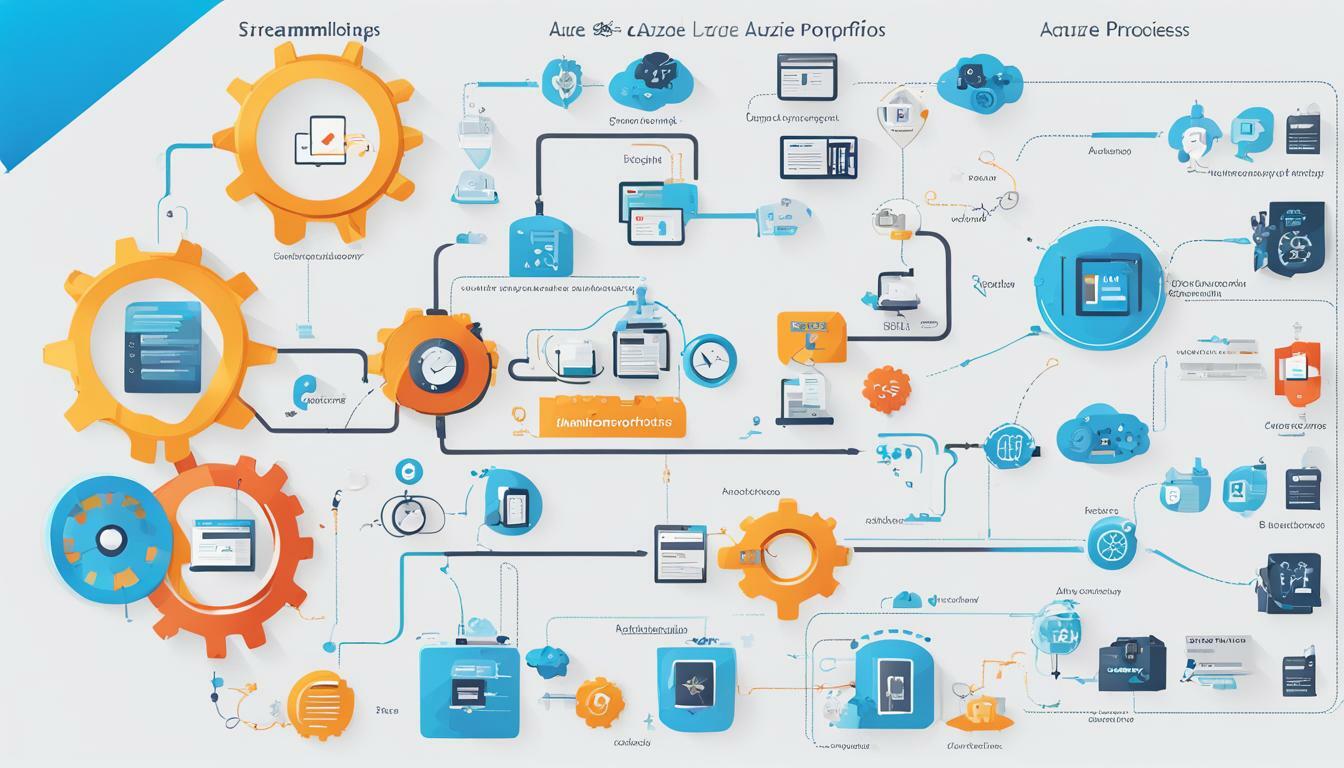
Welcome to our guide on mastering Azure Logic Apps. In today’s fast-paced business world, automating processes is crucial for maintaining a competitive edge. This is where Azure Logic Apps come in – an Azure integration service designed to simplify the creation and management of cloud workflows.
Logic Apps leverage the power of Azure’s workflow engine and pre-built connectors to enable businesses to automate repetitive tasks, improve efficiency, and reduce errors. In this guide, we will explore the fundamentals of Azure Logic Apps, its integration capabilities, and the event-driven architecture approach offered by the platform.
Key Takeaways
- Azure Logic Apps is an Azure integration service designed for creating and managing cloud workflows.
- Logic Apps simplify business process automation, improving efficiency and reducing errors.
- Azure Logic Apps leverage pre-built connectors to integrate with other Azure services and third-party applications.
- The event-driven architecture approach offered by Azure Logic Apps enables businesses to build scalable and responsive workflows.
Understanding Azure Logic Apps
At its core, Azure Logic Apps is a cloud-based workflow solution that enables businesses to create and manage workflows using pre-built connectors. It leverages Azure’s powerful workflow engine, allowing businesses to build complex cloud workflows that integrate with various services and systems with ease.
The platform is designed to simplify and streamline business process automation, making it an ideal solution for a diverse range of industries and use cases. With Azure Logic Apps, businesses can automate repetitive tasks, improve efficiency, and minimize errors, all while reducing the need for extensive coding knowledge.
The cloud-first approach of Azure Logic Apps also enables businesses to build and run workflows that scale easily, ensuring they can keep up with changing business needs without requiring significant investment in infrastructure or resources.
| Azure Logic Apps Features | Description |
|---|---|
| Cloud Workflows | Azure Logic Apps enables the creation and management of cloud workflows using pre-built connectors. |
| Azure Workflow Engine | Leveraging Azure’s powerful workflow engine, Azure Logic Apps allows businesses to build complex workflows that integrate with various services and systems with ease. |
| Pre-built Connectors | With a growing library of pre-built connectors, Azure Logic Apps enables businesses to quickly and easily integrate with various systems and services. |
Overall, Azure Logic Apps offers a reliable and scalable solution for businesses looking to automate their workflows and streamline their processes. With its cloud-first approach, pre-built connectors, and powerful workflow engine, it’s no wonder that Azure Logic Apps is quickly becoming the go-to solution for business process automation.
Simplifying Business Process Automation with Azure Logic Apps
Business process automation can be complex and time-consuming. With Azure Logic Apps, however, it can be simplified and streamlined, allowing businesses to improve their efficiency, reduce errors, and automate repetitive tasks.
Azure Logic Apps provides a visual workflow designer that allows businesses to easily design, build, and customize their workflows without requiring extensive coding knowledge. This means businesses can create workflows tailored to their specific needs, while also ensuring they are intuitive and easy to use.
Designing Workflows with Azure Logic Apps
Azure Logic Apps offers a visual workflow designer that empowers businesses to easily design, build, and customize their workflows without extensive coding knowledge. The visual interface ensures that businesses can quickly create powerful and efficient workflows that can streamline their processes.
The visual workflow designer in Azure Logic Apps offers an intuitive drag and drop interface that allows users to define the steps of their workflows. The logic apps designer is based on a trigger and action model. Workflows begin with a trigger, which is used to start the workflow. The trigger is followed by one or more actions that define the workflow steps. The process is completed when the workflow executes the final action.
Using the visual designer, businesses can leverage pre-built connectors to integrate with various systems and services. Azure Logic Apps offers a wide range of pre-built connectors that enable businesses to connect with popular services and systems, including Salesforce, GitHub, and SharePoint. By leveraging these connectors, businesses can easily integrate their workflows with other systems and streamline their automation processes.
Benefits of using the visual workflow designer
The visual workflow designer in Azure Logic Apps provides several benefits for businesses. Firstly, it enables non-technical users to create complex workflows without extensive coding knowledge. The drag and drop interface makes it easy for users to configure their workflows and define the steps required to complete a process.
Secondly, the visual workflow designer allows businesses to easily modify their workflows as their needs change. The ability to add, remove and reorder steps in the workflow means that businesses can quickly adapt their workflows to meet new requirements.
Finally, the visual workflow designer enables businesses to create powerful and efficient workflows that can streamline their processes. By automating repetitive tasks and reducing manual intervention, businesses can improve efficiency and reduce errors.
Integration Capabilities of Azure Logic Apps
Azure Logic Apps offers seamless integration capabilities with other Azure services and third-party applications. This enables businesses to connect their systems and data sources for streamlined automation.
Thanks to the Azure Integration Service, Logic Apps can easily integrate with Azure services such as Azure Functions, Azure Service Bus, and Azure Event Grid. The Azure Integration Service also allows for hybrid integration scenarios, allowing businesses to connect their on-premises systems to cloud-based workflows.
In addition to the Azure services, Logic Apps also offers a wide range of connectors that allow businesses to connect to popular third-party applications and services. These connectors include Salesforce, Google Drive, Dropbox, Slack, Twitter, and many others. This means businesses can extend their automation capabilities beyond just Azure services and create fully integrated workflows.
| Azure Services | Third-Party Connectors |
|---|---|
| Azure Functions | Salesforce |
| Azure Service Bus | Google Drive |
| Azure Event Grid | Dropbox |
| Slack | |
With these integration capabilities, Azure Logic Apps provides businesses with a comprehensive solution for their automation needs. By connecting all their systems and data sources, businesses can achieve a fully automated workflow that saves time, reduces errors, and improves efficiency.
Event-Driven Architecture with Azure Logic Apps
Azure Logic Apps offers a powerful event-driven architecture approach that enables businesses to build scalable and responsive workflows. With Logic Apps, businesses can create workflows that automatically trigger responses when specific events occur, such as receiving a new email or a file being uploaded to a specific location. This allows for real-time responsiveness and efficient management of processes.
Event-driven architecture with Azure Logic Apps uses a message-based system, where an event is generated and passed along to each associated step in the workflow. As each step is completed, it generates further events to trigger the next step in the workflow. This approach allows for flexibility and adaptability, as the workflow can be easily modified to accommodate changes in business processes.
Event-driven architecture also offers benefits such as improved fault tolerance and reduced processing time, as workflows only execute when triggered by a relevant event. This ensures that resources are efficiently used, and processes are completed accurately and within a timely manner.
Azure Logic Apps provides a range of triggers and actions that can be used to create event-driven workflows, including Azure Service Bus, Azure Event Hubs, and Azure Event Grid. These triggers and actions can be used to respond to events such as receiving a message, detecting a change in a database, or monitoring social media feeds for specific keywords.
Overall, Azure Logic Apps offers an easy-to-use, efficient, and scalable solution for building event-driven workflows that can handle the complexity of modern business processes with ease.
Unlocking Additional Functionality with Azure Connectors
Azure Logic Apps provides a wide range of pre-built connectors that allow businesses to seamlessly integrate with popular services and systems. These Azure connectors significantly enhance the automation capabilities of Logic Apps, making it an even more powerful tool for businesses looking to streamline their workflows.
With Azure connectors, businesses can connect to various data sources, including applications, databases, services, and APIs. Logic Apps also supports HTTP, FTP, and SFTP connectors, which enable businesses to transfer files and data between different systems with ease.
The list of available connectors is extensive and includes connectors for popular services like Salesforce, SharePoint, Twitter, and Dropbox, among others. This makes it easy for businesses to integrate their existing tools and systems with Logic Apps to build end-to-end workflows.
For instance, a business can use the Salesforce connector to automatically create new leads whenever a new email is received in Outlook. Similarly, the SharePoint connector can be used to copy a file from SharePoint to OneDrive, making it accessible to other teams and departments in the organization.
Azure connectors are a game-changer for businesses looking to automate their processes and increase efficiency. With Logic Apps, businesses can connect their systems and data sources like never before, creating a seamless and integrated environment that saves time and resources.
Conclusion
In conclusion, Azure Logic Apps offers a powerful solution for enhancing business process automation. With its cloud workflows, pre-built Azure connectors, and easy-to-use visual workflow designer, Logic Apps simplifies the creation and management of workflows for businesses of all sizes.
Furthermore, the integration capabilities of Azure Logic Apps allow businesses to connect their systems and data sources for streamlined automation. Its event-driven architecture approach enables businesses to build scalable and responsive workflows that can respond to triggers and events in real-time.
By unlocking additional functionality with Azure connectors, businesses can further extend their automation capabilities and integrate with popular services and systems.
In summary, Azure Logic Apps is a valuable tool for businesses looking to enhance their automation capabilities and improve efficiency. We encourage our readers to consider utilizing Azure Logic Apps for their own organizations and experience the benefits of enhanced business process automation.
FAQ
Q: What is Azure Logic Apps?
A: Azure Logic Apps is a cloud-based service provided by Microsoft that allows businesses to create and manage workflows for automating various tasks and processes.
Q: How does Azure Logic Apps enhance business process automation?
A: Azure Logic Apps enhances business process automation by providing a visual workflow designer, pre-built connectors, and integration capabilities with other Azure services and third-party applications.
Q: Can I design workflows in Azure Logic Apps without coding knowledge?
A: Yes, Azure Logic Apps offers a visual workflow designer that allows businesses to design, build, and customize workflows without the need for extensive coding knowledge.
Q: What is the event-driven architecture approach in Azure Logic Apps?
A: Azure Logic Apps offers an event-driven architecture approach, where workflows can respond to triggers and events in real-time, allowing businesses to build scalable and responsive automation.
Q: What are Azure connectors?
A: Azure connectors are pre-built integrations that enable businesses to connect with popular services and systems, extending the functionality of Azure Logic Apps.
Q: How can Azure Logic Apps simplify business process automation?
A: Azure Logic Apps simplifies business process automation by automating repetitive tasks, improving efficiency, and reducing errors through its workflow management capabilities.
Q: Can Azure Logic Apps integrate with other Azure services and third-party applications?
A: Yes, Azure Logic Apps seamlessly integrates with other Azure services and third-party applications, allowing businesses to connect their systems and data sources for streamlined automation.
Q: What are the benefits of using Azure Logic Apps for business process automation?
A: Some of the benefits of using Azure Logic Apps for business process automation include improved efficiency, reduced errors, increased productivity, and the ability to scale workflows as needed.








